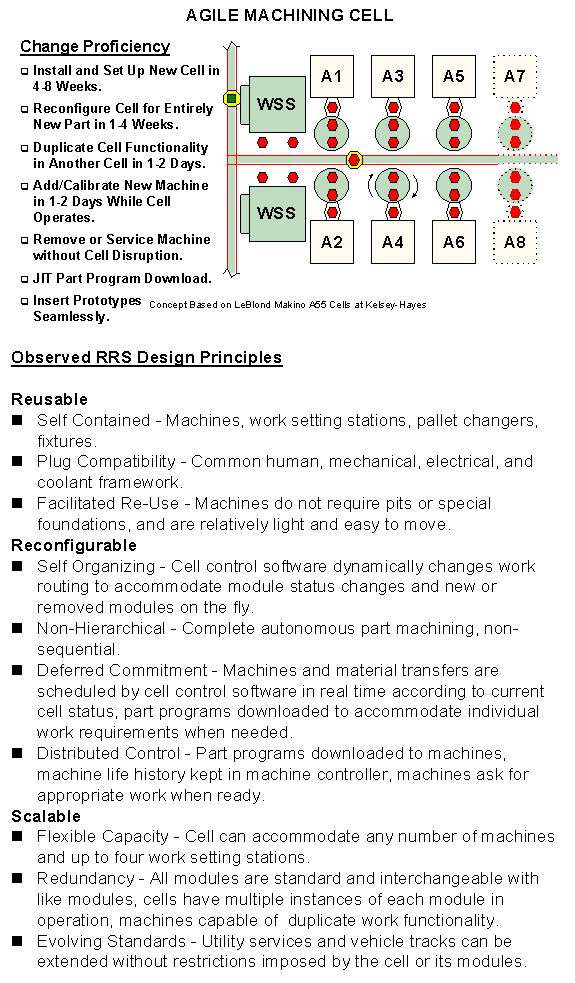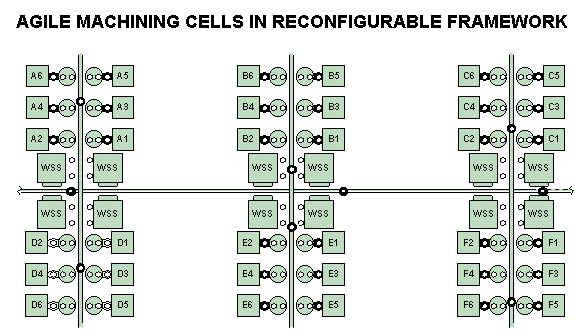Rick Dove, Paradigm Shift
International, www.parshift.com, ![]()
Recently, however, innovators are finding important values in quick market response: rapid new product introduction, accommodation to unpredictable demand, fast prototype turnaround, non-premium-priced pre-production runs, efficient ECO incorporation, longer equipment applicability, and the latitude to accept (or insource) atypical production contracts to improve facility utilization.
These new Agile system values now challenge applications where transfer lines and dedicated machinery have traditionally reigned - and their applicability is based upon concepts that push beyond the traditional flexible values. "On Cells at Kelsey-Hayes" (Production Magazine, Feb 95) has an excellent discussion about these Agile values with the Kelsey-Hayes decision to build two entirely cellular plants for the production of ABS and other braking systems. "We want to achieve a strategic advantage on product cost and delivery" was the vision voiced by Richard Allen, president of their Foundation Brake Operations.
We are not talking mass customization here, with custom configured products. We are talking about fundamental change in the value structure of the high-volume-car / high-volume-brake markets. Technological advances in ABS systems has cut each succeeding product generation’s life-time in half.
The trend to higher automotive-system integration and more technology promises even more change. Car companies want leadership in functionality and feature, and faster times to market; and can’t afford to feature obsolete systems when competitors innovate. Kelsey-Hayes sees opportunity in this faster paced, less predictable market.
Let’s look at some change proficiency issues first. This will put the problem in perspective for us and provide a basis for evaluating the depicted solutions. In actual practice we would do a more complete "change domain analysis" that identifies all key change issues and assesses change proficiency with metrics for cost, time, robustness, and scope (see prior essays).
Product life-cycle for ABS has dropped from ten years to three years over three generations of product, and is expected to go lower yet - so taking 4-6 months to retool a dedicated transfer line is a significant part of the production life - not good. As automakers mine new niche markets and increase total systems integration in standard models the frequency of ABS model change increases. Within this shortened life of any model is the increasing frequency of modifications to add feature advantages and necessities. Of course all these modifications and new models don’t spring to life from pure paper - they each need prototypes and small pre-production runs.
Automakers like most everyone else have never been able to forecast demand accurately, and it’s only getting worse. Coupled with new JIT requirements and reduced finished goods auto inventories the automakers need to throttle production in concert with demand on a week-by-week basis. Suppliers must either be proficient at capacity variation or face increased costs with their own finished goods inventories
Well, the ABS market isn’t alone in this application of technology and continual improvement as we will see with a look at some machine tool advances.
Previously (Sep 95) we looked at an example of an Agile machine architecture, and how those machines might (and do) support an Agile production operation. Here we will continue the illumination of design principles that give us Agility by looking at an Agile cell architecture and how it supports an Agile production operation. Both the Agile cell and the Agile production environment depicted make use of capabilities and configurations possible with the LeBlond Makino A55 machining centers, and are substantially similar to actual installations. Perhaps other vendors can provide a similar capability, our purpose in using the LeBlond example is to show that these concepts are real and not imagined.
The depiction of the Agile machining cell includes a synopsis of some of the change proficiencies obtained by the configuration. Flexible machining cells have been implemented in many places, but the Agile configuration here brings additional values. The configuration and the specific modules were chosen to increase the responsiveness to identified types of change. The LeBlond Makino A55 horizontal machining centers do not require pits or special foundations, so they are (relatively speaking) readily movable. A cell can increase or decrease its machining capacity in the space of a day and never miss a lick in the process. This is facilitated by a plant infrastructure of common utility, coolant, mechanical, and human interfaces that provide a framework for reconfiguring modules easily. These and other Reusable-Reconfigurable-Scalable Agile system principles (introduced in prior essays) are detailed in the depiction.
It is accepted knowledge that replacement or massive retooling of a rigid production module is more expensive than transformation of a flexible production module. Now we see where Agile system configurations can further change the economics to overcome an initial investment that has been higher. "Has been" should be stressed. The price\performance ratios of modular production units are becoming better as we increase our use and increase their production quantities.
Agile production requires neither Agile nor flexible machines - for the Agility is a function of how the modules of production are permitted to interact. An Agile system must be readily reconfigurable, and may gain this characteristic by simply having a very large variety of compatible but inconsistently or infrequently utilized production units.
The toy industry is an example where this is a common approach. Not knowing from year to year what kind of toys the kids will want until a few months before volume deliveries are required, toy manufacturers are either highly vertically integrated (with poor utilization) or broadly leveraged on outsourced manufacturing potential. Agility is a relative issue - and the toy industry has few alternatives to either Agile outsourcing or just-in-case vertical integration. As virtual production concepts mature to support Agile outsourcing, this approach might become more proficient then the just-in-case captive capability alternative - unless of course those practitioners become proficient at insourcing other company’s needs to cover the costs of their insurance base.
From the corporate viewpoint an Agile production capability can be built from a reconfigurable network of outsources. We will look at Agile production from the Agile enterprise viewpoint next time.

